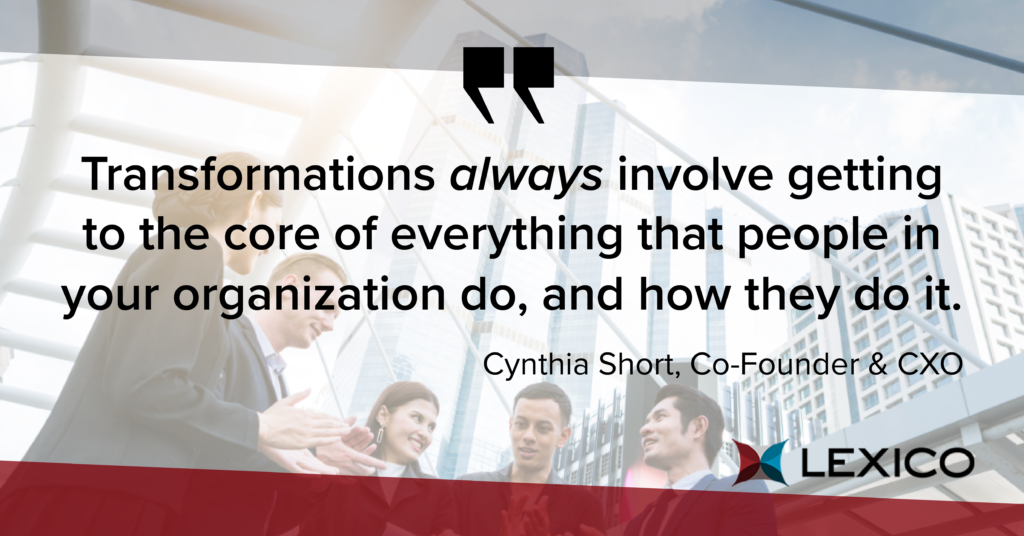
A transformational change initiative is one of the most important things an organization can take on. It’s also one of the most difficult. It can involve widespread changes that affect interconnected pieces throughout the organization, while also dealing with the baggage of an 80%+ failure rate from past experiences. Most importantly, transforming your organization involves getting to the core of everything that people in your organization do, and how they do it.
What is a People Strategy for Transformation?
Here’s one of the most interesting things about transformation: it’s always about people. Even if the customer isn’t squarely the focus of the challenge you’re addressing—perhaps you need to redesign or overhaul a function, or shift the org to be more data-driven—people are at the heart of the work, the impact, and the ultimate success or failure of the initiative.
3 Ways to Prioritize People in Transformation
Plenty of conversations about transformation start because a business needs to correct a relationship issue, or enhance the way people connect with others. Perhaps an organization is experiencing customer service challenges or wants to find ways to reach new customers to support growth. Conversations such as these are certainly people-driven.
1. Plan Around People
Regardless of processes, strategies, deliverables and outcomes, people are the true bottom-line drivers of a transformation initiative. In fact, it’s easier to make transformational change happen when people at every level—board, executive, project, and functional teams—are behind the initiative, and understand why it matters.
As a leader, it’s important to give them the tools and opportunities they need to move in step with the change. In fact, this type of people-first mindset can easily apply to just about anything you want to accomplish in your organization. One of the main reasons that transformational change doesn’t succeed is because a leader overlooks the needs of people involved. To help stay focused on people, we encourage leaders to apply a consistent framework they can come back to again and again. This can be as simple as asking yourself key questions at the different stages of transformational change:
- Do people throughout the organization still feel like they are part of the process? What evidence supports this?
- Have I equipped them with ways to track their progress and contribution at this stage?
- Have I helped them answer fundamental questions, such as ‘Why does this matter?’ and ‘How will this affect me going forward?’
- Have I been responsive to questions? What new questions are popping up?
- What people/teams are embracing this initiative? Which ones could use more support?
2. Reluctance Isn’t Always a Bad Thing
People will respond to different levels of transformation and organizational change in many different ways—and their responses will change at different times. Some may be excited about a change, especially if they’ve been requesting it. Others may be afraid of it, or skeptical of whether or not it will result in anything better or impactful than what they already know.
The Difference Between Change and Transformation
In almost every change initiative, leaders are bound to run into reluctance from certain people or groups. This reluctance might be related to a philosophical belief about what transformation is:
- People may be happy with the way things are, and not see the reason to change.
- Others might be worried about disruptions that the change may cause, especially for themselves.
Failure of Previous Transformational Change Initiatives
Reluctance is a natural part of the change process, especially in environments where previous initiatives have failed. Before you lose sleep trying to ‘win people over,’ you can start to pave the way forward by recognizing and accepting reluctance as a natural reaction, and not a sign of something bigger. Mindset and framing is imperative to be able to lead people through. To help, keep a few other questions in mind:
- What is at the core of this reluctance? (This first question is key. At the end of the day, reluctance is rarely about the change itself. People and teams are usually afraid of, or resisting something else. Understanding this is essential.)
- Are people afraid of the process, or the results that will come after the process is over?
- What data or proof points can I share to help people understand the process as well as the benefits?
You can also gain support from those who are excited about the transformation:
- What’s driving their motivation for this change?
- What can I learn from them in order to improve communications across the board?
3. People and Transformation in Every Approach
When you look at something as critical as transformation, there are dozens of approaches, processes and tools to use. While it’s easy to talk about process and technology as being key enablers to change, people are the ultimate engine and accelerant to transformation work. They set the tone that affects the entire environment as you move forward.
No matter what type of transformational change you’re taking on—adding new technology, changing a process, looking to expand into a new market, etc.—how well you focus on your people will make the difference between failure and success.
Lexico supports executives, leaders and teams to successfully navigate and deliver transformative change. We pay particular attention to the human impact related to all levels of change. What changes are you facing in 2022? Find out how Lexico can support your people and your goals.
